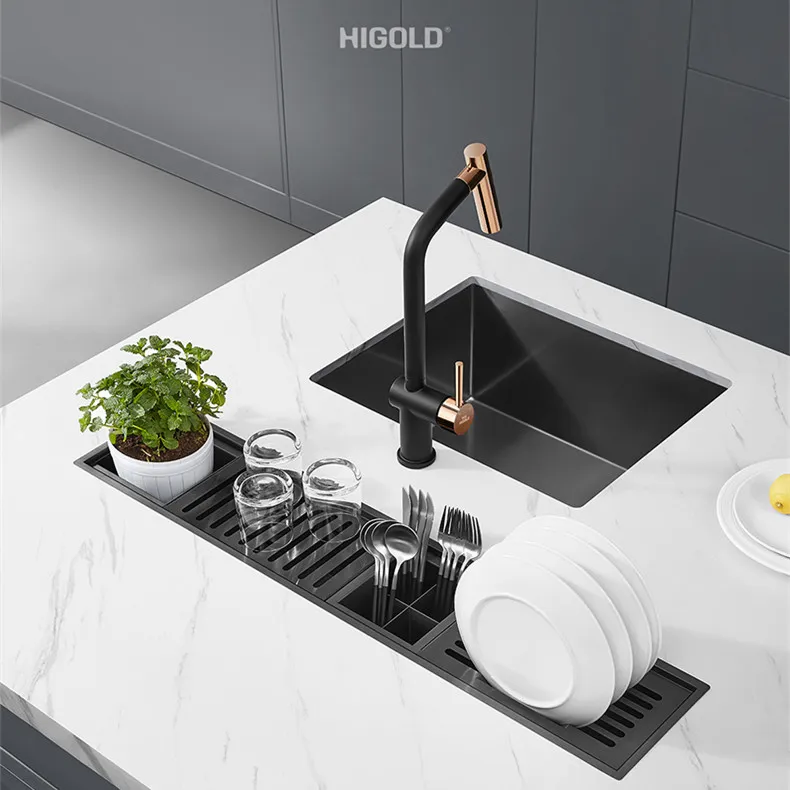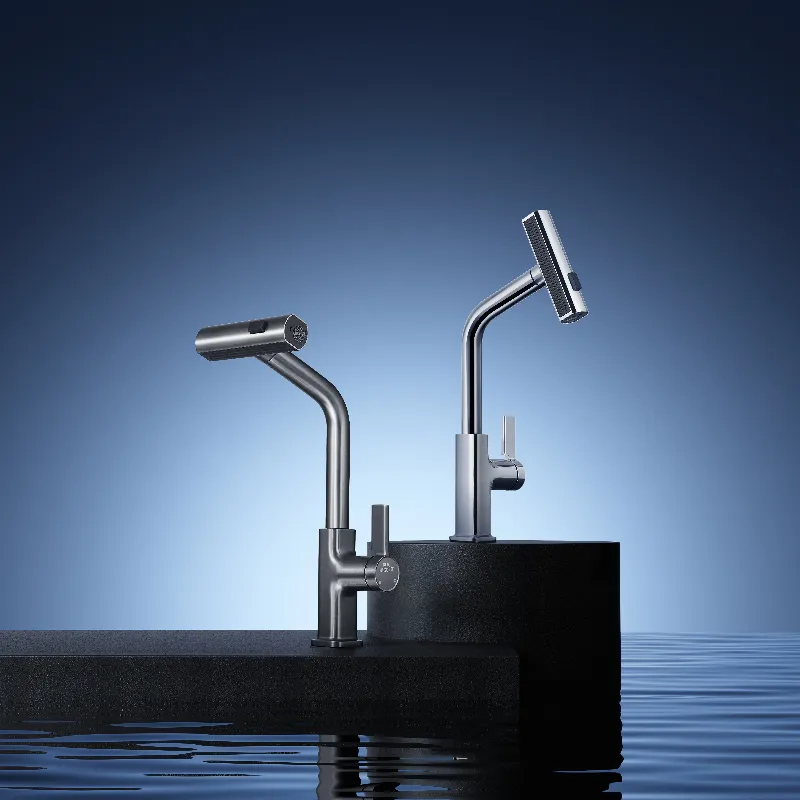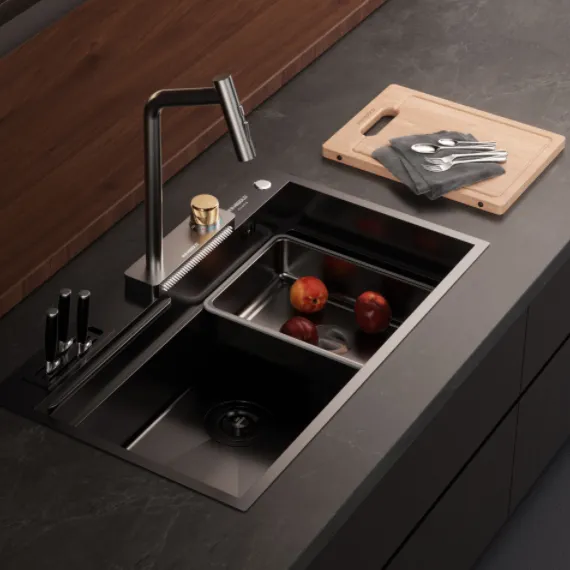The design and functionality of a kitchen sink are an important part of home kitchen decoration, and the number and configuration of faucet holes have an important impact on the kitchen experience. With the diversification of family needs and kitchen functions, the number of faucet holes in kitchen sinks has become more and more diverse.
When consumers choose a kitchen sink, they often face the following question: How many faucet holes are suitable for a sink? What is the impact of different hole numbers on the functional use of the kitchen?
This article will explore the impact of the number of faucet holes on the kitchen sink from the perspective of functional requirements, design trends, and ease of use, and give consumers reference suggestions when choosing.

What is the role of the faucet hole in the kitchen sink?
In a kitchen sink, the faucet hole (also known as the mounting hole) is where faucets, accessories, and other related facilities are installed. The number and location of the faucet holes will directly determine the usability and functionality of the sink. The faucet hole in the kitchen sink is usually used to install faucets, but it can also be used to install other accessories, such as dishwashing liquid bottle holders, filters, spray heads, etc.
The number of faucet holes in a sink usually ranges from 1 to 4. For a single-hole sink, it may only support one traditional faucet; while a sink with multiple holes can be installed with multiple faucets, sprayers, or other kitchen accessories to meet different kitchen needs.
Single-hole sink design
Single-hole sinks are one of the most traditional and simplest sink designs, and are usually suitable for kitchens with simpler spaces and low functional requirements. Single-hole sinks only support the installation of one faucet, so they have fewer installation holes and the changes brought to the kitchen decoration are also relatively simple.
1. Suitable for simple kitchen design
The design of single-hole sinks is usually suitable for small kitchens or simple-style families that do not require high kitchen equipment. Due to the diverse functions of modern kitchens, single-hole sinks are suitable for families who do not have too many additional needs. For example, if the family does not need to install additional food processing devices, spray heads, or water quality filtration devices, then the single-hole design is a suitable choice.
2. Simplify the installation process
One of the advantages of single-hole sinks is that the installation process is relatively simple. Compared with the design of multiple faucet holes, the single-hole sink does not require too many additional access pipes or accessories, reducing the complexity of kitchen decoration. Therefore, for consumers with limited budgets or tight decoration schedules, the single-hole sink design is a time-saving and cost-effective option.
3. Suitable for traditional faucets
The single-hole sink design is usually suitable for traditional single-handle faucets, which are easy to use, simple to operate, and relatively easy to adjust the water flow and water temperature. Therefore, for families who do not require too much kitchen operation, the single-hole sink provides an economical and practical solution.
4. Limiting additional functions
However, the single-hole design also has some limitations. For kitchens that need to install multiple accessories at the same time, the single-hole sink cannot meet the needs. For example, if the family needs to install accessories such as dishwashing liquid bottle racks, food waste disposers or spray heads next to the sink, the functions of the single-hole sink are somewhat limited. In this case, consumers may need to install additional accessories next to the sink or choose a more complex sink design.
Double-hole sink design
Double-hole sinks are a common kitchen sink design, suitable for kitchens with slightly more space or families that need more functions and accessories. The double-hole design usually has one hole for installing the faucet, and the other hole can be used to install a dishwashing liquid bottle holder, spray head or other accessories.
1. Support for additional accessories
One of the biggest advantages of double-hole sinks is that they can be installed with two different accessories at the same time. Usually, one hole is used to install the faucet, and the other hole can be installed with a spray head. The spray head can provide a stronger water flow for washing pots and pans, and can also be used to clean the inside of the sink. This design makes the kitchen more convenient to use, without the need to frequently adjust the position and angle of the faucet.
In addition, the double-hole sink design can also be installed with a food waste disposer or a water quality filter to further enhance the functionality of the sink. Therefore, double-hole sinks are more suitable for families whose kitchens need more auxiliary tools and functions.
2. Suitable for medium-sized kitchens
Double-hole sinks are suitable for families with spacious kitchen space and need a certain functional improvement. This type of design can take into account multiple usage needs at the same time and meet the daily needs of the family. For families who need to wash dishes while washing vegetables, or want to use the dishwashing liquid bottle separately from the faucet, a two-hole sink is a suitable choice.
3. Increase the convenience of kitchen operation
The two-hole design allows multiple accessories to be installed, making kitchen operation more convenient. For example, when a faucet is installed in one hole, the other hole can be used by family members to use the spray head to wash ingredients or other kitchen utensils, avoiding the confusion caused by multiple people using the same faucet at the same time. In short, the design of the two-hole sink makes the kitchen more functional and more flexible to use.

Three-hole and four-hole sink design
Three-hole and four-hole sinks are more suitable for large kitchens or families with higher functional requirements. Generally, three-hole and four-hole sinks provide greater design flexibility and can support multiple faucets, spray heads, garbage disposals, water quality filtration devices, etc. Although these designs may seem a bit too complicated for most families, the three-hole and four-hole designs are particularly practical for large families or families with higher requirements for kitchen equipment.
1. Suitable for kitchens that require multiple functions
Three-hole and four-hole sink designs are common in commercial kitchens, large family kitchens or families with complex needs. For example, a four-hole sink can be installed with a faucet, spray head, garbage disposal and water quality filtration device at the same time to achieve multiple functions of the sink. In this way, different sink accessories can work at the same time, avoiding the situation where faucets with different functions compete with each other and improving the work efficiency of the kitchen.
2. Adapt to the diverse needs of the family
For families that need to use multiple faucets at the same time, the three-hole and four-hole designs can meet this demand. In addition to installing basic faucets, families can also install additional equipment according to actual needs, such as equipping a spray head specifically for washing vegetables or fruits, or installing an additional water quality filtration system to ensure the quality of water.
3. Suitable for large space kitchens
Three-hole and four-hole sink designs are usually suitable for kitchens with more space, which can accommodate multiple accessories and avoid equipment crowding. For users with multiple family members and higher kitchen needs, this type of design can provide more operating space and options.

How to choose the number of sink holes that suits you?
When choosing the number of holes for a kitchen sink, you first need to consider the kitchen space and usage requirements. Sinks with different numbers of holes are suitable for different kitchen environments and functional requirements. Here are some purchase suggestions:
● Space and budget: If the kitchen space is small and the budget is limited, choosing a single-hole sink is usually the most economical and appropriate choice. For families who do not have too many additional functional requirements, the single-hole design is sufficient for daily use.
● Functional requirements: If the family kitchen has more functional requirements, such as the need to install a spray head, garbage disposal or water quality filtration device, then a two-hole, three-hole or four-hole sink design will be more suitable. The two-hole design is the most common kitchen choice and is suitable for most families.
● Family size and frequency of use: For large families or families who use the kitchen frequently, a multi-hole design can provide stronger functional support. Three-hole and four-hole sinks are suitable for users who have a high frequency of use and have more requirements for kitchen equipment.
How Does Higold Maintain High Standards of Quality in Its Products?
At Higold, quality is at the forefront of everything we do. Our kitchen sinks and faucets undergo rigorous testing and inspection to meet international standards. We use high-quality materials like SUS304 stainless steel and advanced manufacturing techniques, such as laser cutting, robotic welding, and ultrasonic cleaning, to ensure durability and precision. Whether you're looking to buy in bulk or require customized solutions, our products are designed to meet your exact specifications and exceed your expectations.


